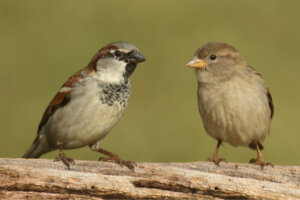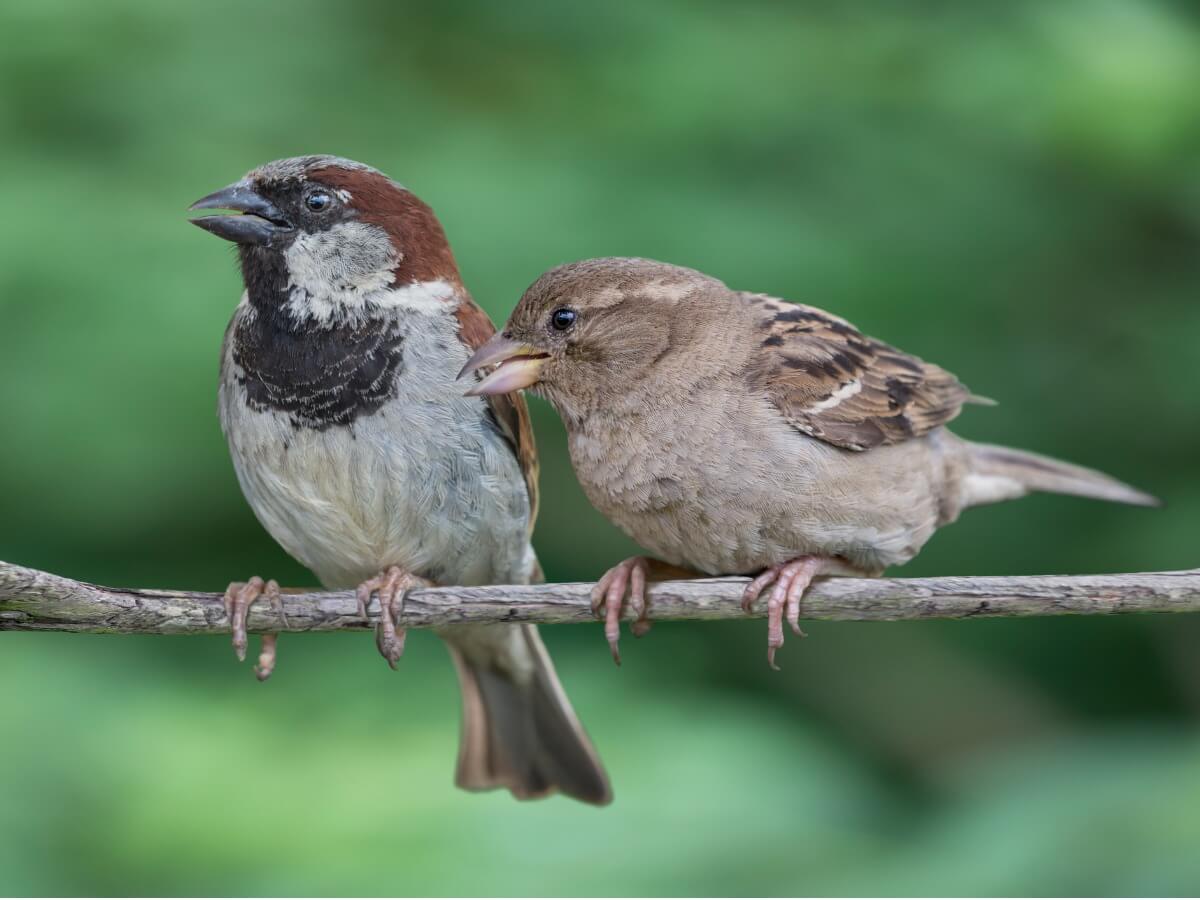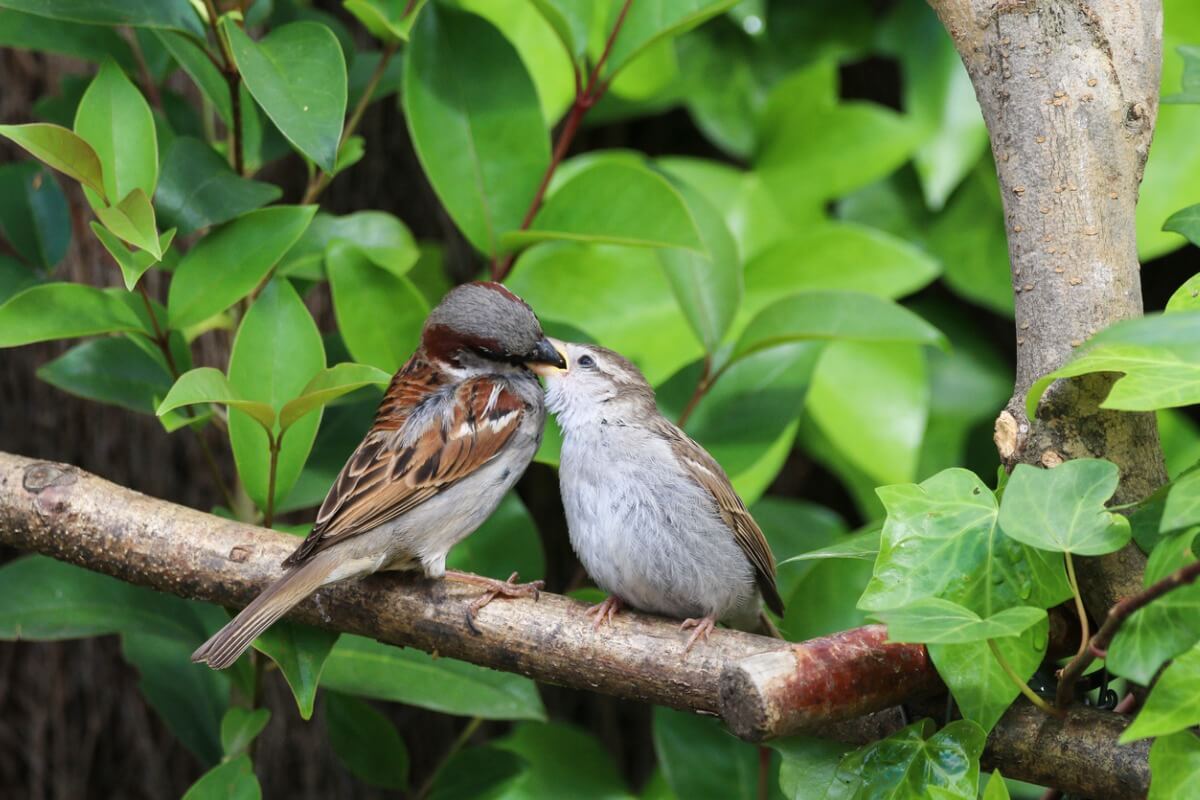6 Differences Between Male and Female Sparrows


Written and verified by the biologist Cesar Paul Gonzalez Gonzalez
The house sparrow is a small bird native to Europe and Asia, which has been introduced to the Americas, Africa and Australia. It’s a regular member of urban environments, so it’s common to see it flying around our towns and cities. Because it’s a fairly hardy species, some people have chosen to keep it as a pet. Sparrows exhibit marked sexual dimorphism, so there are very obvious differences between male and female sparrows.
Thanks to this, it’s possible to identify the sex of a specimen without needing any special equipment. Continue reading and find out the most notable characteristics of both sexes.
What are sparrows?
The scientific name of the house sparrow is Passer domesticus, it belongs to the group of songbirds (Passeriformes), and is widespread in North America. It’s approximately 14 to 18 centimeters long ( 6 to 7 inches) and weighs between 24 and 40 grams (1 to 1.8 oz). It exhibits a plumage with different shades of gray and brown, but their patterns depend on sex and specimen.
This bird is very social and usually form flocks with several of its fellow species. The groups tend to form communal choruses, so their songs become common and quite loud in some cities. They lose a bit of their friendly nature during the breeding season, although most of the time couples nest very close to each other without any problem.
Why are male and female sparrows different?
Like other birds, sparrows exhibit sexual dimorphism. This means that the characteristics of males are different from those of females. These traits are usually useful for reproduction, as the birds communicate with each other through visual cues that allow them to evaluate potential mates.
Another reason why the two sexes are different is because of susceptibility to predation. Females can’t exhibit very conspicuous characteristics, as this would make them and their offspring easier to find. In this way, nature ensures that mothers are more likely to survive and allows the species to continue.
Males are more conspicuous in the environment due to their coloration, but they take that risk in order to have more reproductive capacity. This concept is known as trade-off.

Dimorphic characteristics of the house sparrow in females and males
To distinguish between male and female sparrows, all you have to do is pay close attention to their appearance. The birds are small and quite elusive, so sometimes it can be quite a challenge to distinguish between them. Even so, you can use some of the following traits to help you do so.
1. The head
The plumage that adorns the head of the male sparrow is usually gray with some bright brown feathers. On the other hand, the female only exhibits ashy brown shades that are less exuberant. This characteristic is very easy to observe, as it completely changes the face of each specimen.
2. The throat
Sparrows are characterized by having a lighter belly than the rest of their body, but males sport a black band that elegantly highlights their throat. Females don’t have this feature and their color follows the brownish hue of their entire body.
3. The beak
During the breeding season, sexual dimorphism intensifies and some new features appear. The beak of the males is one of the parts that change during the mating season, as it takes on a striking black color that makes them easier to identify. During the rest of the year, this structure maintains the same brown shades that the females have.
4. Black mask
The face of the male sparrow has a beautiful black mask that goes around and between his eyes. In some cases, this dark plumage extends around the beak and connects to the dark throat band, making it look “bearded”.
5. Full body color
The male sparrow’s plumage is usually brighter and contrasting with a mix of brown, black, white, and brownish colors. Females, on the other hand, exhibit only ash-brown shades that closely resemble earth. These differences are further accentuated during the mating season.
6. The size of the eggshell
Birds are oviparous animals that lay eggs for reproduction. During incubation, it’s very unlikely that you’ll be able to tell if it’s going to be male or female, so the sex of the bird is only known when it hatches. However, in this species, there’s a way to distinguish between the two.
According to a study published in the journal Behavioral Ecology and Sociobiology, the size of the eggs depends on the sex. This means that, inside the nest, the larger shells house the males and the smaller ones the females. At least in this species, it’s possible to identify the sex of the specimens even before they hatch.

Identifying the differences between male and female sparrows isn’t as difficult as in other species. Therefore, if you’re a good observer and use some of the above guidelines, then you should be able to detect the sex of each one without any problem.
The house sparrow is a small bird native to Europe and Asia, which has been introduced to the Americas, Africa and Australia. It’s a regular member of urban environments, so it’s common to see it flying around our towns and cities. Because it’s a fairly hardy species, some people have chosen to keep it as a pet. Sparrows exhibit marked sexual dimorphism, so there are very obvious differences between male and female sparrows.
Thanks to this, it’s possible to identify the sex of a specimen without needing any special equipment. Continue reading and find out the most notable characteristics of both sexes.
What are sparrows?
The scientific name of the house sparrow is Passer domesticus, it belongs to the group of songbirds (Passeriformes), and is widespread in North America. It’s approximately 14 to 18 centimeters long ( 6 to 7 inches) and weighs between 24 and 40 grams (1 to 1.8 oz). It exhibits a plumage with different shades of gray and brown, but their patterns depend on sex and specimen.
This bird is very social and usually form flocks with several of its fellow species. The groups tend to form communal choruses, so their songs become common and quite loud in some cities. They lose a bit of their friendly nature during the breeding season, although most of the time couples nest very close to each other without any problem.
Why are male and female sparrows different?
Like other birds, sparrows exhibit sexual dimorphism. This means that the characteristics of males are different from those of females. These traits are usually useful for reproduction, as the birds communicate with each other through visual cues that allow them to evaluate potential mates.
Another reason why the two sexes are different is because of susceptibility to predation. Females can’t exhibit very conspicuous characteristics, as this would make them and their offspring easier to find. In this way, nature ensures that mothers are more likely to survive and allows the species to continue.
Males are more conspicuous in the environment due to their coloration, but they take that risk in order to have more reproductive capacity. This concept is known as trade-off.

Dimorphic characteristics of the house sparrow in females and males
To distinguish between male and female sparrows, all you have to do is pay close attention to their appearance. The birds are small and quite elusive, so sometimes it can be quite a challenge to distinguish between them. Even so, you can use some of the following traits to help you do so.
1. The head
The plumage that adorns the head of the male sparrow is usually gray with some bright brown feathers. On the other hand, the female only exhibits ashy brown shades that are less exuberant. This characteristic is very easy to observe, as it completely changes the face of each specimen.
2. The throat
Sparrows are characterized by having a lighter belly than the rest of their body, but males sport a black band that elegantly highlights their throat. Females don’t have this feature and their color follows the brownish hue of their entire body.
3. The beak
During the breeding season, sexual dimorphism intensifies and some new features appear. The beak of the males is one of the parts that change during the mating season, as it takes on a striking black color that makes them easier to identify. During the rest of the year, this structure maintains the same brown shades that the females have.
4. Black mask
The face of the male sparrow has a beautiful black mask that goes around and between his eyes. In some cases, this dark plumage extends around the beak and connects to the dark throat band, making it look “bearded”.
5. Full body color
The male sparrow’s plumage is usually brighter and contrasting with a mix of brown, black, white, and brownish colors. Females, on the other hand, exhibit only ash-brown shades that closely resemble earth. These differences are further accentuated during the mating season.
6. The size of the eggshell
Birds are oviparous animals that lay eggs for reproduction. During incubation, it’s very unlikely that you’ll be able to tell if it’s going to be male or female, so the sex of the bird is only known when it hatches. However, in this species, there’s a way to distinguish between the two.
According to a study published in the journal Behavioral Ecology and Sociobiology, the size of the eggs depends on the sex. This means that, inside the nest, the larger shells house the males and the smaller ones the females. At least in this species, it’s possible to identify the sex of the specimens even before they hatch.

Identifying the differences between male and female sparrows isn’t as difficult as in other species. Therefore, if you’re a good observer and use some of the above guidelines, then you should be able to detect the sex of each one without any problem.
All cited sources were thoroughly reviewed by our team to ensure their quality, reliability, currency, and validity. The bibliography of this article was considered reliable and of academic or scientific accuracy.
- Cordero, P. J., Griffith, S. C., Aparicio, J. M., & Parkin, D. T. (2000). Sexual dimorphism in house sparrow eggs. Behavioral Ecology and Sociobiology, 48(5), 353-357.
- Johnston, R. F., & Selander, R. K. (1973). Evolution in the house sparrow. III. Variation in size and sexual dimorphism in Europe and North and South America. The American Naturalist, 107(955), 373-390.
- Johnston, R. F. (1967). Sexual dimorphism in juvenile house sparrows. The Auk, 84(2), 275-277.
- Pape Møller, A. (1989). Natural and sexual selection on a plumage signal of status and on morphology in house sparrows, Passer domesticus. Journal of Evolutionary Biology, 2(2), 125-140.
This text is provided for informational purposes only and does not replace consultation with a professional. If in doubt, consult your specialist.








